Related Research Articles

Nadvorna is a Hasidic rabbinical dynasty within ultra-Orthodox Judaism. The dynasty derives its name from the town of Nadvorna, known in Ukrainian as Nadvirna. The town was located in the province of East Galicia in the Austro-Hungarian Empire, until World War I; and between the two world wars, the town was located in Poland.
Shomer Emunim is a devout, insular Hasidic group based in Jerusalem. It was founded in the 20th century by Rabbi Arele (Aharon) Roth.
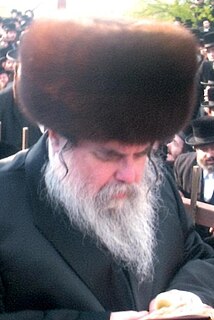
Yissachar Dov Rokeach is the fifth and present Rebbe of the Hasidic dynasty of Belz. He is the son of Rabbi Mordechai of Bilgoray, the grandson of the third Belzer Rebbe, Rabbi Yissachar Dov Rokeach, and the nephew of the fourth Belzer Rebbe, Rabbi Aharon Rokeach, who raised him. He has led Belz since 1966.
Dushinsky is one of the few Hasidic dynasties not named after the place where it originated; instead, it is named after the surname of the Rebbe. It is a relatively new dynasty, as are many of the dynasties originating in Hungary. However, the Dushinsky dynasty truly became a dynasty in Jerusalem, where it is centered today. It is not like other Hasidic groups in that it does not originate from a Hasidic background, but from the talmidim (students) of the Chasam Sofer.
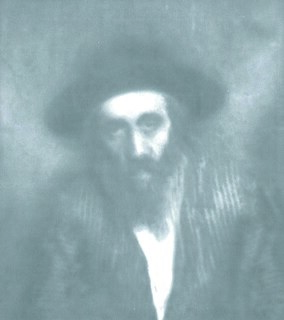
Toldos Aharon is an anti-Zionist Hasidic movement, The group is characterized by conservatism and a desire to preserve the life of the old Yishuv in Jerusalem, in sharp opposition to Zionism, in a strict Haredi way of life, in a special style of clothing, and in an emphasis on prayer at a moderate pace and with enthusiasm. Headquartered in Jerusalem's Meah Shearim neighborhood, it also has significant numbers in Ramat Beit Shemesh, London, and New York City. and additional members in Tiberias and in Harish. The sect has about 1,800 households. Toldos Aharon is a split-off from Shomer Emunim. It is led by its Rebbe, Dovid Kohn.

The Orthodox Council of Jerusalem (OCJ) is a large ultra-Orthodox Jewish communal organization based in Jerusalem, with several thousands affiliated households. It is led by an independent rabbinical court, chaired by the Gaon Convenor, acronymed Ga'avad, and operated by the Rabbi Convenor, Ra'avad. The OCJ provides facilities such as dietary laws supervision, ritual baths, a Sabbath enclosure, and welfare services. The Council was founded in 1921 by devout Ashkenazi residents of Jerusalem, especially of the Old Yishuv, who refused to be affiliated in any way with the new Zionist institutions.
Rabbi Meir Brandsdorfer was a member of the Rabbinical Court of the Edah HaChareidis, the Haredi Ashkenazi community in Jerusalem, and was in charge of their Kashrut operations, especially matters of Shechita.

Rabbi Yitzchok Yaakov Weiss (1902–1989), also known as the Minchas Yitzchak after the series of books of the Responsa he authored, was the rabbi of the Edah HaChareidis, but his halakhic influence also extended beyond the borders of the community as prominent posek, and Talmudic scholar. He was a world-renowned expert on Jewish law.
A Moetzes Gedolei HaTorah is the supreme rabbinical policy-making council of the Agudat Yisrael and Degel HaTorah movements. Rabbis sitting on the various Moetzos are usually either one of the more prestigious Roshei Yeshiva or Hasidic rebbes who are also usually regarded by many Haredi Jews to be the Gedolim ("great/est") sages of Torah Judaism. Before the Holocaust it was the supreme authority for the World Agudath Israel in Europe.
Amram Blau (1894–1974) was a Haredi rabbi in Mandatory Palestine and Israel. He was one of the founders of the fiercely Anti-Zionist Neturei Karta.
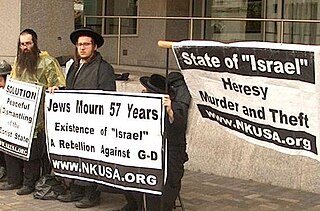
From the start of political Zionism in the 1890s, Haredi leaders voiced objections to its secular orientation, and before the establishment of the State of Israel, the vast majority of Haredi Jews were opposed to Zionism. This was chiefly due to the concern that secular nationalism would replace the Jewish faith and the observance of religion, and the view that it was forbidden for the Jews to re-constitute Jewish rule in the Land of Israel before the arrival of the Messiah. Those rabbis who did support Jewish settlement in Palestine in the late 19th century had no intention to conquer Palestine and declare its independence from the rule of the Ottoman Turks, and some preferred that only observant Jews be allowed to settle there.
Toldos Avrohom Yitzchok is a Hasidic movement located in Jerusalem's Meah Shearim neighborhood. It is an offshoot of the Hasidic group Toldos Aharon, which is in turn an offshoot of Shomer Emunim. It is led by its Rebbe, Rabbi Shmuel Yaakov Kohn.
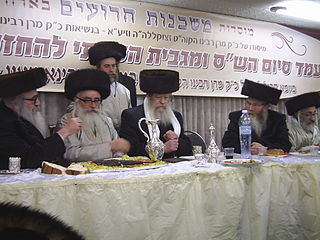
Mishkenos HoRoim, also spelled Mishkenot HaRoim, Mishkenois HaRoyim, is a small Hasidic group located in Meah Shearim, Jerusalem. It is known as a very isolated and fervently religious group, known for its virulent anti-Zionism, even by Haredi standards. Mishkenos HoRoim is also known as Kahal Yereim. The main synagogue is located on Meah Shearim Street. There is also a Mishkenos HoRoim synagogue in Ramat Beit Shemesh Bet.

Rabbi Avruhum Yitzchok Ulman is a senior Haredi rabbi living in Jerusalem.
A badatz is a major Jewish beth din. The term is a modern one and is an acronym for beit din tzedek.

Ami is an international news magazine that caters to the Jewish community. It is published weekly in New York and Israel. The magazine was launched in November 2010 by the husband & wife team of Rabbi Yitzchok Frankfurter and Rechy Frankfurter
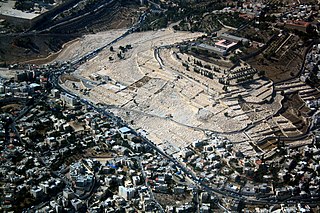
The Jewish Cemetery on the Mount of Olives, including the Silwan necropolis, is the most ancient and most important Jewish cemetery in Jerusalem. Burial on the Mount of Olives started some 3,000 years ago in the days of the First Temple, and continues to this day. The cemetery contains anywhere between 70,000 and 150,000 tombs from various periods, including the tombs of famous figures in Jewish history.
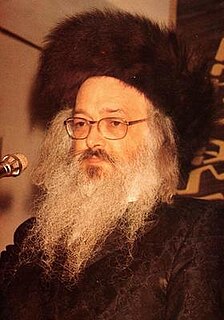
Yisroel Moshe Dushinsky also known as the Maharim, was the second Rebbe of the Dushinsky Hasidic dynasty of Jerusalem, Israel. He assumed the leadership of the Hasidut at the age of 28 upon the death of his father, Rabbi Yosef Tzvi Dushinsky, founder of the dynasty. He was also a member of the rabbinical court of the Edah HaChareidis for over 40 years, completing his tenure as the seventh chief rabbi of the Edah HaChareidis from 1996 to 2003.
Yaakov Yeshayah Blau (1929–2013) was a rabbi and a dayan on the Badatz of the Edah HaChareidis in Jerusalem. He was known as an expert in the halakhot of Choshen Mishpat and served as halakhic decisor for over 50 years.
References
- 1 2 Lando, Michael; Matthew Wagner (2007-08-14). "Satmar rebbe to inaugurate housing project on ruins of Edison Cinema". Jerusalem Post. Retrieved 2008-10-26.[ permanent dead link ]
| This article about a subject related to a Jewish organization is a stub. You can help Wikipedia by expanding it. |
| This Hasidic Judaism article is a stub. You can help Wikipedia by expanding it. |